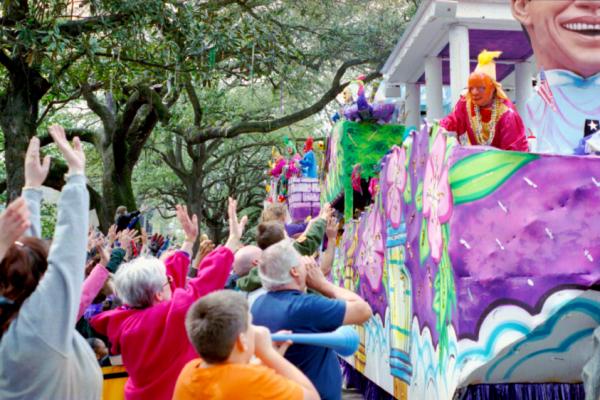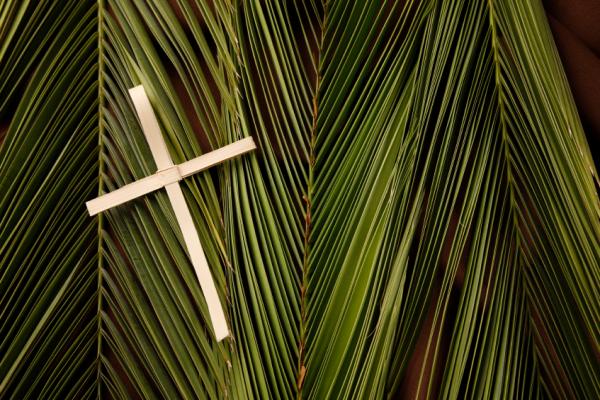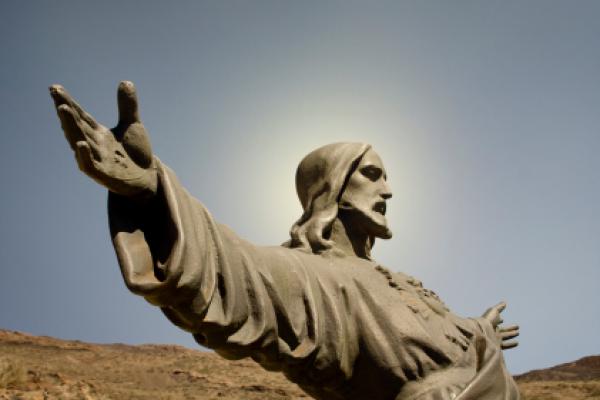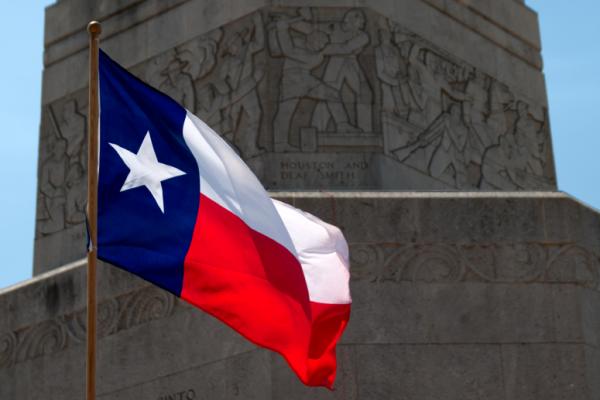Mardi Gras is a holiday in some parts of the United States and often serves as a festive occasion featuring large celebrations. It is also known as Shrove Tuesday, as it is the last day before the long fast for Lent in many Christian churches.
 Mardi Gras festivals often feature parades and large crowds in the United States.
Mardi Gras festivals often feature parades and large crowds in the United States.
©iStockphoto.com/sandoclr
What do people do?
Shrove Tuesday is the last day before Lent, a period for fasting. It is also known as Fat Tuesday, or Mardi Gras, and features large festivals and celebrations across the United States. The Mardi Gras parade in New Orleans, in Louisiana, is typical of the masquerades and dancing in the streets that take place in other parts of the United States before the long Lenten fast.
Traditional Mardi Gras parades in New Orleans spotlight the King of the Carnival and the Monarch of Merriment, as well as Comus, the God of Revelry. Many people dress up in eye-catching costumes and a spectacular ball is held. Debutantes are introduced at the Ball Tablaeu as a formal introduction to society.
People throw trinkets to crowds as part of the customary “parade throw” at New Orleans’ Mardi Gras celebration. During the Bacchus parade, the king’s float throws doubloons with the image of the “Celebrity King” on one side of the doubloon (cups and toy coins) to parade watchers. Traditional Mardi Gras food includes the King Cake in which a pecan or charm is hidden. The person who gets a piece of the cake with the charm or nut is dubbed the “king” of that year’s Mardi Gras.
The Mobile and Baldwin counties in Alabama also celebrate Mardi Gras. Parade schedules start as early as January and feature marching bands, colorful floats, and crowds of parade goers along the streets in downtown Mobile. Galveston, in Texas, hosts its own Mardi Gras celebration, which features masked balls, a royal coronation, Cajun dances, jazz performances and parades with floats.
Public life
Mardi Gras is a state holiday in Louisiana. It is also marked as a holiday in the Baldwin and Mobile counties only in Alabama. Governing authorities of any municipality or county in Mississippi can declare this event as a holiday to replace any legal holiday except Martin Luther King’s Birthday (which is combined with Robert E Lee’s Birthday in the state).
Background and Symbols
Mardi Gras in the United States was first observed in Mobile when it was a colony of French soldiers in 1703. Mardi Gras was transformed into a parade event in 1840 by the Cowbellion de Rakin Society, the first of Mobile’s organizations that journeyed to New Orleans in 1857 to help a group there set up a Mardi Gras celebration. The first Carnival society, known as the Mistick Kreweof Comus, took part in coordinating the event that year.
The event was well received and continued until it was suspended during the American Civil War. Mardi Gras was one of the first local institutions to be revived after the war. It reappeared in 1866 and has continued to grow in modern times. A general article about Shrove Tuesday worldwide covers more information about its background and symbols.
About Shrove Tuesday/Mardi Gras in other countries
Read more about Shrove Tuesday/Mardi Gras.
Courtesy of DateandTime.com
Many Christian Americans mark Ash Wednesday as the first day of Lent. It follows Shrove Tuesday, which features Mardi Gras celebrations.
 Ash is an important symbol of Ash Wednesday in many Christian churches.
Ash is an important symbol of Ash Wednesday in many Christian churches.
©iStockphoto.com/Ben Beltman
What do people do?
Some Christians in the United States attend special Ash Wednesday church services. This includes students who attend Catholic and other church schools. Priests usually place blessed ashes in form of the cross on individuals’ foreheads to remind them of mortality, sorrow for sins, change, and forgiveness.
Ash Wednesday marks the beginning of Lenten discipline for observant Christians. It is traditionally a time of fasting and prayer in preparation for receiving or reaffirming baptism at Easter. For some Christians, Lent is a time to think about one’s life choices and mortality, as well as reflect on life directions. It serves as a wakeup call for some Christians. There are also those who choose this time of the year to donate to charities or take part in charity events as a way to get close to God.
Public life
Ash Wednesday is an observance and not a federal public holiday in the United States.
Background and Symbols
The practice of marking foreheads with ashes is common among Roman Catholics, Anglicans, Lutherans and Episcopalians in the United States. However some Methodist and Presbyterian churches adopted this custom in recent times, especially around the 1990s. A general article about Ash Wednesday worldwide covers more information about its background and symbols.
About Ash Wednesday in other countries
Read more about Ash Wednesday.
Courtesy of DateandTime.com
Many people in countries such as the United States celebrate Chinese New Year, also known as the Spring Festival or the Lunar New Year. It marks the first day of the New Year in the Chinese calendar.
 Chinese New Year decorations, including red envelopes for money.
Chinese New Year decorations, including red envelopes for money.
©iStockphoto.com/Liang Zhang
What do people do?
Many individuals and communities, particularly Chinese communities, in the United States take part in the Chinese New Year celebrations, which can last for days. Chinese New Year celebrations in the United States have, over the years, included activities and events such as:
- Chinese New Year parades featuring colorful costumes, floats, firecrackers and other attractions.
- Various dances, including lion and dragon dances.
- Chinatown fun runs or walks.
- Balls and pageants.
- Street fairs.
- Firework displays.
Some organizations may hold special contests or make announcements to coincide with Chinese New Year. For example, some newspapers or magazines may announce the top 10 Chinese restaurants in a city or town on Chinese New Year. It is customary for many Chinese-American families to spend time together and exchange gifts, including money wrapped in red and gold packages that are usually given to children.
Public life
Chinese New Year is not a federal public holiday in the United States. However, some Chinese businesses may be closed on the day or amend their business hours to take part in the Chinese New Year festivities. There may be heavy traffic and some streets may be closed in towns or cities where Chinese New Year celebrations are held.
Background
According to the U.S. Census Bureau (Census 2000: Chinese Largest Asian Group in the United States; March 4, 2002), the Chinese comprised more than 20 percent of the 11.9 million people who identified themselves as Asians in the United States’ Census 2000. That translates into 2.7 million reporting as Chinese – the largest Asian group in the United States.
Chinese historical organizations in the United States can trace the arrival of the Chinese in North, Central and South America as far back as the 1600s. Many Chinese immigrants settled in the United States during the 19th century. With immigration, came Chinese traditions and events such as Chinese New Year, which is now largely celebrated in many communities across the United States.
Symbols
Chinese New Year has various symbols and traditions. For example, flowers are an important part of New Year decorations. Writings that refer to good luck are often seen in homes and business environments. They are usually written by brush on a diamond-shaped piece of red paper. Tangerines and oranges are also displayed in many homes and stores as a sign of luck and wealth.
Envelopes with money (Hong Bao, Ang Pao, or Lai See) often come in the color red, which symbolizes happiness, good luck, success and good fortune. These envelopes are mainly given as presents to children. Each Chinese New Year is associated with an animal name for one of 12 animals in the Chinese zodiac.
About Chinese New Year in other countries
Read more about Chinese New Year.
Courtesy of DateandTime.com
St Patrick’s Day occurs on March 17 and is day to remember one of Ireland’s patron saints, St Patrick. It largely celebrates Irish-American culture in the United States, and the use of the color green is predominant.
 Irish related stories, such as one about the Leprechaun’s pot of gold, are often told on St Patrick’s Day.
Irish related stories, such as one about the Leprechaun’s pot of gold, are often told on St Patrick’s Day.
©iStockphoto.com/SharapaAndriy
What do people do?
St Patrick’s Day celebrations concentrate on Irish themed parties, alcoholic drinks and food. People celebrating often dress in green clothing and may consume food and drink dyed green. Irish clubs and pubs often hold special events or promotions. Large street parades are held to mark St Patrick’s Day in cities such as:
- Chicago.
- Boston.
- Houston.
- Philadelphia.
- Pittsburgh.
- Denver.
- Detroit.
- Toronto.
- New York.
- New Orleans.
- Seattle.
Parades are held on Saturday, March 16, in New York during the years when March 17 is a Sunday. The parade is always held on the Sunday before March 17 in many other cities. Some people see St Patrick’s Day as a celebration of the color green, rather than solely focusing on the Irish-American culture. Water is dyed green in public places in some towns. The most notable body of water that was dyed green was the Chicago River in 2005.
People dress in green clothing and eat food, which is either naturally or dyed green, on St Patrick’s Day. Some people go as far as holding green dinner parties where the guests are expected to wear green and eat exclusively green food.
Public life
St Patrick’s Day is not a federal holiday in the United States. Schools, businesses and organizations are open as usual. Public transport systems run on their regular schedules. There may be some local disruption to traffic due to St Patrick’s Day parades. This is particularly true in cities with a large Irish-American population, including New York, New Orleans and Seattle. The parades may be on or around March 17, so it is a good idea to check local sources for the exact location, date and time.
Background
St Patrick is one of Ireland’s patron saints and many Americans with Irish ancestry remember him on March 17. Patrick’s Day is fixed on March 17, but may occasionally be moved by the authorities of the Catholic Church. This happened in 1940, so that the celebrations would not fall on Palm Sunday, and in 2008 to avoid Holy Monday, the last Monday before Easter Sunday.
Symbols
The most common St Patrick’s Day symbol is the shamrock. The shamrock is the leaf of the clover plant and a symbol of the Holy Trinity. Other symbols include:
- Almost anything colored green.
- The green, orange and white flag of the Republic of Ireland.
- Brands of beer associated with Irish culture.
Religious symbols include snakes and serpents. Other Irish-related symbols seen on St Patrick’s Day include the harp, which was used in Ireland for centuries, as well as a mythological creature known as the leprechaun and a pot of gold that the leprechaun hides.
About St. Patrick’s Day in other countries
Read more about St. Patrick’s Day.
Courtesy of DateandTime.com
Many Christians in the United States remember Jesus’ triumphal entry into Jerusalem on Palm Sunday, which marks the beginning of Holy Week. This day is also on the Sunday before Easter Sunday.
 The palm and the cross are Christian symbols that are seen in churches at a Palm Sunday service or mass.
The palm and the cross are Christian symbols that are seen in churches at a Palm Sunday service or mass.
©iStockphoto.com/duckycards
What do people do?
Programs of sacred music are performed in many towns and cities in the United States on Palm Sunday. They are often sponsored by and held in local churches but they may also be part of the musical community’s regular concert series. These programs usually begin on or before Palm Sunday and may continue throughout Holy Week. Bethany College’s Messiah Festival in Lindsborg, Kansas, has been held during Holy Week for more than 100 years.
Plays or pageants that focus on Holy Week themes are also performed on Palm Sunday. The Blessing of the Fleet in St Augustine, Florida, takes place on Palm Sunday each year. Shrimp trawlers and other fishing boats, as well as privately owned vessels, visit the town to receive a blessing. It is also customary for Christians to place blessed palm leaves in the shape of a cross behind religious images or statues in homes, stores and restaurants in the United States.
Public life
Palm Sunday is not a federal holiday in the United States. However, it is held on a Sunday, which is a non-school day and non-working day for many Americans.
Background and Symbols
Palm Sunday is observed among many Christian churches as part of Holy Week in the United States. The term Pascua Florida, which in Spain originally referred to Palm Sunday, was later applied to the festive season of Easter Week. The state of Florida received its name when Ponce de Leon first sighted the land and named it in 1513 most likely because the date was around Easter.
Palm leaves symbolize victory and joy among many Christians in the United States. Some churches use silk plant leaves or substitute palm leaves with olive branches on Palm Sunday because palm leaves can be difficult to find in some areas in the United States.
About Palm Sunday in other countries
Read more about Palm Sunday.
Courtesy of DateandTime.com
Good Friday occurs two days before Easter Sunday in the United States. It is the day when Christians commemorate Jesus Christ’s crucifixion, which plays an important part in the Christian faith. It is not a federal holiday in the United States, although it is a state holiday in some states.
 Good Friday remembers the death of Jesus Christ.
Good Friday remembers the death of Jesus Christ.
©iStockphoto.com/kelly cline
What do people do?
Some Christians may attend special church services or prayer vigils. Good Friday is a day of mourning and quiet prayer for many Christians. The candles are often extinguished and statues, paintings and crosses may be draped in black, purple or gray cloth. Some Catholics treat Good Friday as a day of fasting, while others observe a partial fast involving the exclusion of meat.
Some homes keep a quiet atmosphere, with little or no outside activities and limited television, radio, and computer use, in observing Good Friday. Others choose to play music such as JS Bach’s St. Matthew’s Passion. Some people bake hot cross buns, a traditional Good Friday sweet.
Good Friday is another day at work for many Americans, as it is not a national holiday. Some people may choose to take a day off work and have a long “Spring Break” weekend. In some states, employees are given a day off on Good Friday.
Public life
Good Friday is not an official holiday in the United States. Regular services will continue according the schedule in some areas, including Toledo, Ohio, where the city’s refuse will be collected during its regular schedule. However, financial markets, as well as many businesses, public schools and universities/colleges are closed on Good Friday.
Good Friday is a state holiday in some states such as Hawaii, where city and state offices are closed and some forms of public transport (eg. buses) run on the state holiday schedule. In some areas, such as Perry County in Tennessee, Good Friday is a school holiday. Good Friday is a holiday designated by the governor as a day of fasting and prayer in Connecticut.
In accordance with state law, Indiana state employees are given a day off on Good Friday, a religious holiday. In 1999, in the case of Bridenbaugh v O’Bannon, an Indiana state employee sued the governor for giving state employees Good Friday as a day off. The US Seventh Circuit Court of Appeals ruled against the plaintiff, stating that the government could give state employees a paid day off when that day is a religious holiday, including Good Friday, but only so long as the state can provide a valid secular purpose that coincides with the obvious religious purpose of the holiday.
Background
Good Friday is the day when Christians commemorate the crucifixion and death of Jesus Christ. The Easter date depends on the ecclesiastical approximation of the March equinox.
This is an important event in Christianity, as it represents the sacrifices and suffering in Jesus’ life. The crucifixion was the culmination of a number of events in Holy Week, including: the triumphal return of Jesus to Jerusalem on Palm Sunday; the washing of the disciples’ feet by Jesus; and the Last Supper on Maundy Thursday. Some churches organize a prayer vigil on Good Friday for various causes, such as for cancer patients or for the American troops who have been sent to the middle-east.
Symbols
The crucifix, or cross, which represents the way Jesus died, is an important symbol seen on Good Friday. Some crosses bear a figure of Christ. Other symbols of Good Friday include black cloth used to cover the cross, paintings and statues in churches and some homes to signify mourning.
About Good Friday in other countries
Read more about Good Friday.
Courtesy of DateandTime.com
Many Christians celebrate Jesus Christ’s resurrection on Easter Sunday. The Easter date depends on the ecclesiastical approximation of the March equinox.
 Easter Sunday celebrates the Christian belief of Jesus Christ’s resurrection from the dead.
Easter Sunday celebrates the Christian belief of Jesus Christ’s resurrection from the dead.
©iStockphoto.com/ Marcus Lindström
What do people do?
Many churches hold special services on Easter Sunday, which celebrate the Jesus Christ’s resurrection after his crucifixion. Many people also decorate eggs. These can be hard boiled eggs that can be eaten later, but may also be model eggs made of plastic, chocolate, candy or other materials. It is also common to organize Easter egg hunts. Eggs of some form are hidden, supposedly by a rabbit or hare. People, especially children, then search for them. In some areas, Easter egg hunts are a popular way for local businesses to promote themselves or may even be organized by churches.
Public life
Easter Sunday is not a federal holiday but a number of stores are closed in many parts of the US and if they are open, they may have limited trading hours. In some cities, public transit systems usually run their regular Sunday schedule, but it is best to check with the local transport authorities if any changes will be implemented during Easter Sunday.
Background
In Pagan times, many groups of people organized spring festivals. Many of these celebrated the re-birth of nature, the return the land to fertility and the birth of many young animals. These are the origins of the Easter eggs that we still hunt for and eat.
In Christian times, the spring began to be associated with Jesus Christ’s crucifixion and resurrection. The crucifixion is remembered on Good Friday and the resurrection is remembered on Easter Sunday. The idea of the resurrection joined with the ideas of re-birth in Pagan beliefs.
Symbols
For people with strong Christian beliefs, the cross that Jesus was crucified on and his resurrection are important symbols of the period around Easter. Other symbols of Easter include real eggs or eggs manufactured from a range of materials, nests, lambs and rabbits or hares. Sometimes these symbols are combined, for example, in candy models of rabbits with nests full of eggs. Eggs, rabbits, hares and young animals are thought to represent the re-birth and return to fertility of nature in the spring.
About Easter Sunday in other countries
Read more about Easter Sunday.
Courtesy of DateandTime.com
Many United States residents mark Tax Day as the deadline to file their income tax details to the Internal Revenue Service (IRS). The date is usually on or around April 15. However, this deadline may be extended to accommodate holidays or extreme weather conditions.
 Tax Day is an important date to remember.
Tax Day is an important date to remember.
©iStockphoto.com/joel-t
What do people do?
A large proportion of residents of the USA have to inform the IRS of all income that they received in the previous fiscal year. Some groups, particularly veterans, pensioners and some low-income families, do not have to file a tax return unless they wish to qualify for certain types of income subsidy. Others may wait until the last moment to file their tax return and pay any money they owe. Some people may find that filing a tax return is complicated, while others may feel that they should not have to pay income tax. In the United States, income tax returns may be filed on paper or electronically. Now, people are encouraged to file a return via Internet as this is efficient and reduces the risk of mistakes being made or documents being lost in the post.
Public life
Tax Day is not a federal public holiday in the United States. Schools, post offices, stores and other businesses and organizations are open as usual. Public transport services run to their usual schedules and no extra congestion on highways is to be expected.
Background
Income tax was first introduced in the United States of America in 1861. A rate of three percent was levied on incomes above $800 per year and the resulting revenue was used to help fund the American Civil War effort. However, income tax was seen as unconstitutional and the law was repealed in 1872. The idea of a tax on personal income, at a rate of two percent, was reintroduced in the Revenue Act of 1894, but the legal status of this kind of tax was still unclear. In 1913, the “Sixteenth Amendment” to the Constitution of the United States was ratified. This cleared the way for the modern income tax system in the USA.
The details of the income tax system have changed greatly since 1913. The top rates of tax have varied enormously and were particularly high during the First and Second World Wars and the Great Depression. Individuals and families with very low levels of income do not have to pay income tax and may receive some subsidy via the tax system.
In 1913 Tax Day, or the filing deadline, was fixed on March 1. However, it was moved to March 15 in 1918 and April 15 in 1955, where it has remained since then. If April 15 falls on a Saturday, Sunday or a civil holiday, such as Patriot’s Day, the deadline is extended to the next working day. An extension due to a holiday may only affect certain states. In 2007, the residents of some states were granted an extension due to the disruption to public life in many areas caused by a huge Nor’easter storm. In some years in Washington DC, Emancipation Day may be the reason to extend the deadline for filing an income tax return (Tax Day). In 2007, the observance Emancipation Day in Washington DC had the effect of nationally extending the 2006 income tax filing deadline from April 16 to April 17. This 2007 date change was not discovered until after many forms went to print.
Courtesy of DateandTime.com
San Jacinto Day is a day of state pride for many Texans in the United States on April 21 each year. It commemorates a battle between the Texas Army and Mexican forces about 25 miles from downtown Houston, Texas, on April 21, 1836. This became known as the Battle of San Jacinto and was a turning point for Texas’ independence from Mexico.
 San Jacinto Day is a day for Texans to be proud of their history.
San Jacinto Day is a day for Texans to be proud of their history.
©iStockphoto.com/Lanier
What do people do?
On San Jacinto Day, many people show their pride at being Texan by flying the state flag of Texas, often called the Lone Star Flag, from their homes or other buildings. The main event is a re-enactment of the San Jacinto Battle at the San Jacinto Battleground State Historic Site on a Saturday close to April 21. The re-enactment by hundreds of volunteers is very realistic and includes the use of costume, canons and pyrotechnics. It also forms the center of a festival, which includes a wide range of family entertainment and highlights aspects of Texan history, culture and nature.
Public life
San Jacinto used to be, but is no longer, a public holiday in the state of Texas. Many schools are open, as are post offices, stores and other businesses and organizations. Public transport services run to their usual schedules. Some state offices are closed or partially staffed and services may be restricted. San Jacinto Day is not a public holiday in other parts of the United States on April 21.
Background
Around 1820, the area that is now Texas was part of the newly independent country of Mexico. However, many of the inhabitants wished to form the independent Republic of Texas and, in 1835, they drafted the Texas Declaration of Independence and formed a provisional government. This movement was supported by a wave of volunteers from the United States. In 1836, the president of Mexico, General Santa Anna, travelled to Texas to bring down the uprising. The beginning of his campaign was successful and the Mexican forces managed to regain control of a number of areas.
The Battle of San Jacinto occurred on April 21 in 1836 and was won by Texan forces. The battle lasted a total of 18 minutes and only nine Texan soldiers were killed and 26 wounded. However, hundreds of Mexicans were killed, injured or captured and General Santa Anna was captured in the aftermath of the battle. This event led to negotiations for Texas to become fully independent from Mexico.
Symbols
An important symbol of San Jacinto Day is the flag of the state of Texas, which is flown on homes and other buildings on April 21. This flag is known as the Lone Star Flag and consists of three parts. The flag is one-and-a-half times as wide as it is high. The vertical third, which is hung closest to the flag pole, is dark blue with a single white star and represents loyalty. The top half of the remaining two-thirds of the flag is white, to represent purity, and the lower half red, to represent bravery.
The site of the battle is now known as the San Jacinto Battleground State Historic Site, which is close to the Houston Ship Channel and the cities of La Porte and Baytown. The Historic Site is home to the San Jacinto Monument, which is 570 feet (or about 174 meters) high and the world’s tallest masonry tower. The monument is crowned by a massive stone star that represents the state of Texas.
External links
Texas State Library and Archives Commission: Official Texas State Holidays
Courtesy of DateandTime.com
